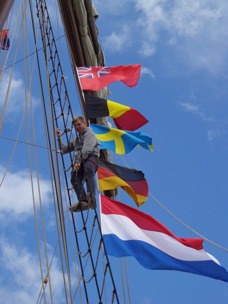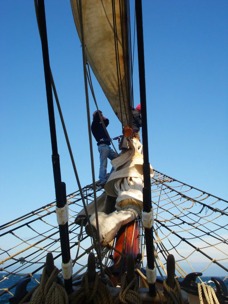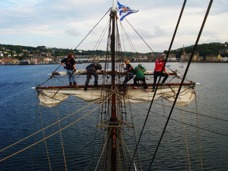WHAT DOES BEING A TRAINEE INVOLVE?
Trainees are young people (between 15 and 25 years of age) enlisted onboard a ship to sail on one (or perhaps several) stages of a race. It’s a challenge that largely suits all young people, regardless of their previous experience or qualifications.
The challenge is not directed exclusively at young people who want to train as sailors, but at all young people who want to develop their language skills, learn about teamwork, find new strengths, visit new countries and cultures, experience a starry night’s sky along the horizon, in the north and in the south, east and west … and above all, make new friends for life!
Costs and Requirements
In order to sail as a trainee, you must meet the following:
* You must be 15 years of age or older
* You must not be older than 25 years of age
* You should be able to understand and make yourself understood in English
* You must be able to swim at least 200 meters.
Required Experience
Previous sailing experience is not necessary. The regular crew will teach you everything you need to know about life onboard the ship. Everything from how to set sail, to navigating the safety regulations. If you aren’t afraid of heights, you can even climb the masts. Everyone will help you with your daily tasks on board, from cleaning the deck to helping the chef in the kitchen.
I plan on coming by myself, is that a problem?
Many young people come along by themselves, while others choose to take on the challenge together with a friend. From experience, we can tell you that it doesn’t take long to get to know new people under these conditions. Especially when you are on the same team onboard. Many trainees make friends for life this way!
What makes an international exchange on board a sailing ship so special?
The great thing about international exchanges is that you don’t just learn about sailing and life on board the ship, but also different cultures and countries. Beyond sailing, there are intercultural activities every day that everyone can take part in. At the port, you’ll meet trainees from different countries sailing on ships with the same experience as you - from all over the world! Together you’ll have a great time taking part in, amongst other things, tremendous crew parades and crew parties.
What language is spoken on board?
The main language onboard most ships is English. The crew will speak English, and most instructions and training sessions will be in English. If you’re unsure about anything, the others will clarify it for you and ensure that things are translated along the way. There are many Swedish, Norwegian and Danish vessels you can sail with - which is a source of comfort for many.
What’s it like on board a ship on the open sea?
Onboard the ship your job will be to keep watch. That involves more than just looking out for land ahoy. You’ll be responsible for the ship - together with your trainee friends and the ordinary crew.
You’ll help to navigate, manoeuvre, climb the rigging, set sail, make coffee, prepare food and keep up everyone’s spirits onboard.
The most common way of working onboard is with a well-mixed three shift watch system. Every watch team has two shifts a day, for example:
Blue) 08:00 - 12:00 / 20:00 - 24:00,
Red) 12:00 - 16:00 / 24:00 - 04:00,
Green) 04:00 - 08:00 / 16:00 - 20:00
Life on board is quite different from day to day and the various watch systems all have their own charms when it comes to weather, wind and views. From sunshine to rain, and from dolphins that swim alongside the boat to unbelievably beautiful sunsets.
What insurance do I need for my trip and my stay onboard?You need to be have insurance policies for the following:
1. Health insurance for your home country
2. Travel insurance that covers healthcare costs abroad, lost baggage and third person liability
Each ship has a liability insurance policy which covers you in the case of injury relating to work onboard.
Am I insured during my journey to and from the ship?
Check with your travel insurance policy. Ensure that it covers all travel days and insurance protection, and not just the days you will be on board the ship.
Passport
Remember to bring your passport, alongside all of your insurance details!
Costs
Each trainee place costs one “boardprice,” but there are opportunities to have your place financed, either in full or in part. Read more at the Sponsorship and Grants page.
TIPS!
Do you want to sail as a trainee under the Tall Ships Races, but haven’t got sponsorship?
Pack a bag, take your passport, your insurance papers and some travel money (in Euros). Take yourself to the nearest Tall Ships Races and get in touch with the ships directly! From experience, there are always a few drop-outs, and with around a hundred ships gathered together in the one place you have a good chance of finding a trainee space - and at a really good ‘last minute’ price, too.
All ships are inspected by Sail Training International and they will also display approval papers from a maritime administration. If you’re completely unexperienced, you can always get in touch with STA-S before you enlist.

Mathias Kindberg in the act of trainee onboard Gulden Leeuw 2012. Photo: Caroline Nordstrandh

Trainees onboard Astrid 2011
Photo: Ida Johansson

Trainees set sail on Tallship Astrid.
Photo: Ida Johansson
